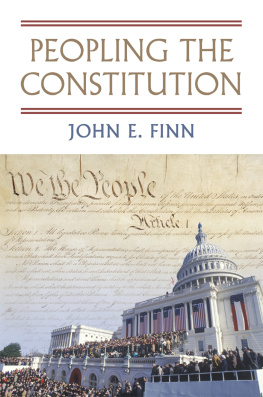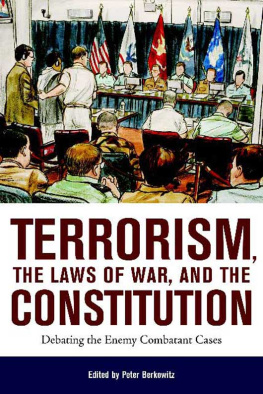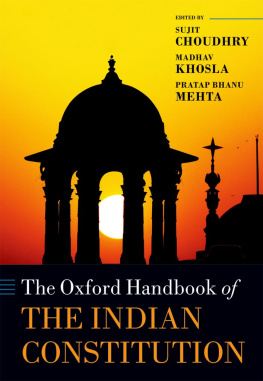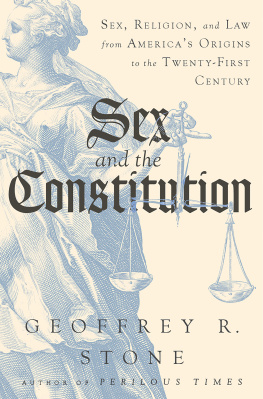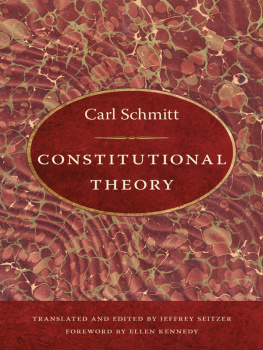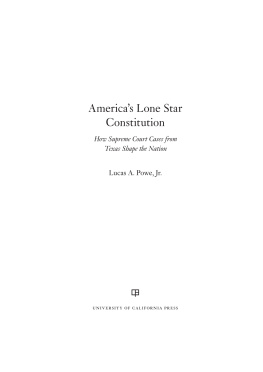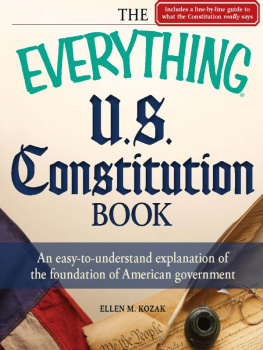The Transformative Constitution
A RADICAL BIOGRAPHY IN NINE ACTS
Gautam Bhatia

HarperCollins Publishers India
Contents


A S A PRACTISING LAWYER, I was professionally involved with four of the cases discussed in this book: the constitutional challenge to Section 377 of the IPC (Chapter 2), the right to privacy case (Chapter 7), the bail applications of Kabir Kala Manch before the Supreme Court (Chapter 8), and the constitutional challenge to Aadhaar (Epilogue). Readers may like to take my views on these judgements with a healthy dose of scepticism, given that I was an active participant in these cases, and held (and continue to hold) definitive views about them.
The Supreme Court judgements in the adultery challenge (Chapter 1), the Section 377 challenge (Chapter 2), and the Sabarimala temple entry case (Chapter 5) were delivered after I had finished writing this book. There was no time to integrate them into the body of the chapters. Because of their importance to the argumentand, more broadly, to the project of transformative constitutionalismI have instead addressed them in brief postscripts to each chapter.
A version of Chapter 2 was published earlier as Equal moral membership: Naz Foundation and the refashioning of equality under a transformative Constitution, (2017) 1(2) The Indian Law Review 115 (Publisher: Taylor & Francis); of Chapter 4 as Horizontal Discrimination and Article 15(2) of the Indian Constitution: A Transformative Approach, (2016) 11(1) The Asian Journal of Comparative Law 87 (Copyright: Cambridge University Press); and of Chapter 5 as Freedom from community: Individual rights, group life, state authority, and religious freedom under the Indian Constitution, (2016) 5(3) Global Constitutionalism 351 (Copyright: Cambridge University Press). These have been slightly edited to fit the scheme of this book, and are reprinted with the permission of the publishers.

On 26th January 1950, India will be an independent country.
B.R. Ambedkar, in his closing speech to the Constituent Assembly (1949)
We have it in our power to begin the world over again.
Thomas Paine (1776)
I N MARCH 1948, THE ruler of Sant, a princely state in western India,) rights over certain forests. It was to be one of the concluding royal acts in Sants 700-year-long history. By June 1948, Sant had become one of the last princely states to accede to the newly independent Indian Republic.
Within a year, the State of Bombaywith which Sant had mergedreneged on the grant.
Various aggrieved parties (the respondents) the territorys inhabitants under the previous regime. In acquiring Sant, the government had exercised its sovereign prerogative and decided not to recognize the forest grant. This was an act of State that was immune from judicial challenge.
The respondent-citizens objected strongly. They argued that this rule was a relic of the imperialistic and expansionist philosophy of British Jurisprudence, not simply wipe out their rights when it assumed sovereignty over the state of Sant.
But by a wafer-thin 43 majority, the Supreme Court held in favour of the State. In his concurring opinion, Justice J.C. Shah addressed the constitutional argument of the respondent-citizens, and rejected it in the following words:
There is no warrant for holding at the stroke of midnight of the 25th January,
Justice Shahlike his colleagues in the majorityelected to follow the jurisprudence of the Privy Council, which had been the law laid down and given effect to until India attained independence. Bose had set his face firmly against the Privy Councils Act of State doctrine. As with the respondent-citizens before the Supreme Court in 1964, he had founded his argument in the moment of constitutional framing:
In our opinion, the Constitution blotted out in one magnificent sweep all vestiges of arbitrary and despotic power in the territories of India and over its citizens and lands and
even after the adoption of the new Constitution.
The disagreement between Justice Shah and Justice Bose was not merely over whether the jurisprudence of the Privy Council should be followed, but over meaningwhat was the meaning of the historical event that was the framing of the Indian Constitution? For Justice Shah, that event signified continuity: marked by words and phrases such as continuance, evolution, gave shape, and change in form. For Justice Bose, on the other hand, it marked transformation: a past that was blotted out, abandoned, obliterated; and a new order that was born.
That is why Justice Shah took the unusual step of attacking Justice Bose for his understanding of history and constitutional theory. The judgements of Justices Shah and Bose reflected contesting views of history, and, based upon that history, contesting views about what the Constitution of India represented.
And the difference mattered. It mattered vividly in 1954 and 1964 in determining the legality of the States refusal to recognize the pre-existing rights of its citizens. It had mattered before in 1950, when in its very first decision the Supreme Court had upheld the constitutionality of preventive detention laws that replicated their colonial antecedents. And it has mattered ever since, whether it is a landmark Supreme Court judgement upholding the fundamental right to privacy, or a barely noticed judgement of a high court applying the guarantee of gender equality to pregnancy-based discrimination. At the heart of every constitutional decision is the courts assessment of what the Constitution means, why it exists in the shape and form that it does, and, above all, what injustices it is meant to remedy.
This book advances Justice Boses vision of the Constitution, a vision that understood both the historical moment of framing, and the Constitution itself, as fundamentally remains marginalized in a judicial history that has overwhelmingly endorsed Justice Shahs view of conservatism and continuity.
I. The Conservative Constitution
In characterizing the Constitution as a conservative document, Justice Shah was not arguing in a vacuum. His references
The purveyors of this tradition could count among themselves an authority as eminent as B.N. Rau, the Constitutional Advisor, who began his To justify the idiom of transfer (as opposed to transformation), they could also call upon some formidable evidence.
First, the Constituent Assembly itself was no revolutionary body. It derived its own authority from the Cabinet Mission Plan of 1946, and its members were elected
Second, the Constituent Assembly borrowed heavily from the 1935 Government of India Act. As much as 75 per cent of the Indian Constitution was based on that colonial law. of the Government of India Act, because:
a Federal Constitution had been established under the Government of India Act, 1935, and though that has undergone considerable change by way of repeal, modification and addition, it still remains the framework on which the present Constitution is built
Where then was the break with the past, the rupture with the colonial regime, that Justice Bose
And, in particular, the Constitution replicated some of the very provisions that had been the subject of bitter protests during the course of the freedom struggle. These included preventive detention, granting the political executive the power to pass ordinances bypassing legislative procedure, as well as the power to effectively suspend the legal system by declaring If the Constitution was meant to be transformative, surely it should have, at the very least, repudiated these hallmarks of arbitrary power instead of endorsing them?
Next page


